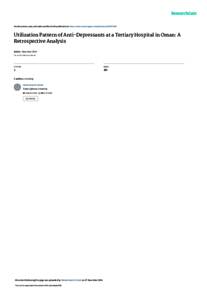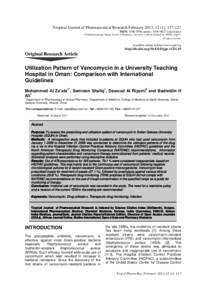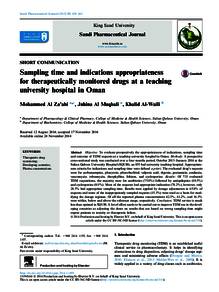Document
Utilization pattern of anti-depressants at a tertiary hospital in Oman : a retrospective analysis.
Identifier
DOI: 10.4172/Psychiatry.1000163
Contributors
Al-Jabri, Asaad S., Author
Al-Bartamani, Jabran K., Author
Publisher
In House Publications.
Gregorian
2014-09
Language
English
Subject
English abstract
Introduction: Antidepressants play a major role in managing depression and other conditions. The use of various classes of antidepressants varies from a country to another but information about the use of these agents in the developing countries is scarce. Objective: To assess the use of different classes of antidepressant medications in a tertiary hospital in Oman. Method: Data over four month period (January to April 2013) were retrieved retrospectively after obtaining ethical approval. Results: A total number of 1416 prescriptions were analyzed. Of these 880 (62.1%) were for females and 536 (37.9%) were for males. Tricyclic antidepressant (TCAs), selective serotonin reuptake inhibitors (SSRIs), serotonin/ norepinephrine reuptake inhibitors (SNRIs) and mirtazapine accounted for 34.6%, 32.1%, 13.3% and 19.9% of prescriptions, respectively. Monotherapy accounted for 89.3% of prescriptions. The most used single antidepressant drug was amitriptyline (28.5%) followed by mirtazapine (19.9%) and paroxetine (17.9%). SSRIs, SNRIs and mirtazapine were mainly used for psychiatric conditions in 82.2%, 73.0% and 68.8% of the cases, respectively, while TCAs were mainly indicated (63.7%) for non-psychiatric conditions. Conclusion: Monotherapy antidepressant is the preferred mode of therapy with SSRIs and mirtazapine as first line therapy for depression which is consistent with therapeutic guidelines recommendations.
Member of
ISSN
1994-8220
Resource URL
Citation
Al-Za'abi, Mohammed, Al-Jabri, Asaad S., & Al-Bartamani, Jabran K. (2014). Utilization Pattern of Anti-Depressants at a Tertiary Hospital in Oman: A Retrospective Analysis. Journal of Psychiatry. 17 (6), [1-5].
Category
Journal articles



